Perge , The City of Colonnaded streets
Introduction
Perge Travel Guide : Perge, located 19 km east of Antalya, used to be one of the most important cities of ancient Pamphylia. Its most notable son was Apollonius, a mathematician and an astronomer who who gave the ellipse, the parabola, and the hyperbola the names by which we know them. In ancient times, Perge was also renowned as a sanctuary dedicated to the goddess Artemis whose temple stood on a hill outside the town. Unfortunately, despite intensive searching, researchers have so far failed to find any traces of this once magnificent building. Ancient Perge is famous by the fact that when Saint Paul started his journeys, he visited Perge in 46 AD. and preached his first sermon here. That is why it became an important city for the Christians during Byzantine period. All the remains of the city can be seen in this area. Social and cultural buildings reflecting the majesty of the Perge Ancient City are the necropolis, theatre, city walls, stadium, gymnasium, Roman baths, rectangular planned agora, high towers, monumental fountains, column lined streets, Greek and Roman gates.
Being part of Pamphylia, the ancient city of Perge says the rise and fall of many civilisations, with their remains surviving to today.
History
Mythology and Prehistory
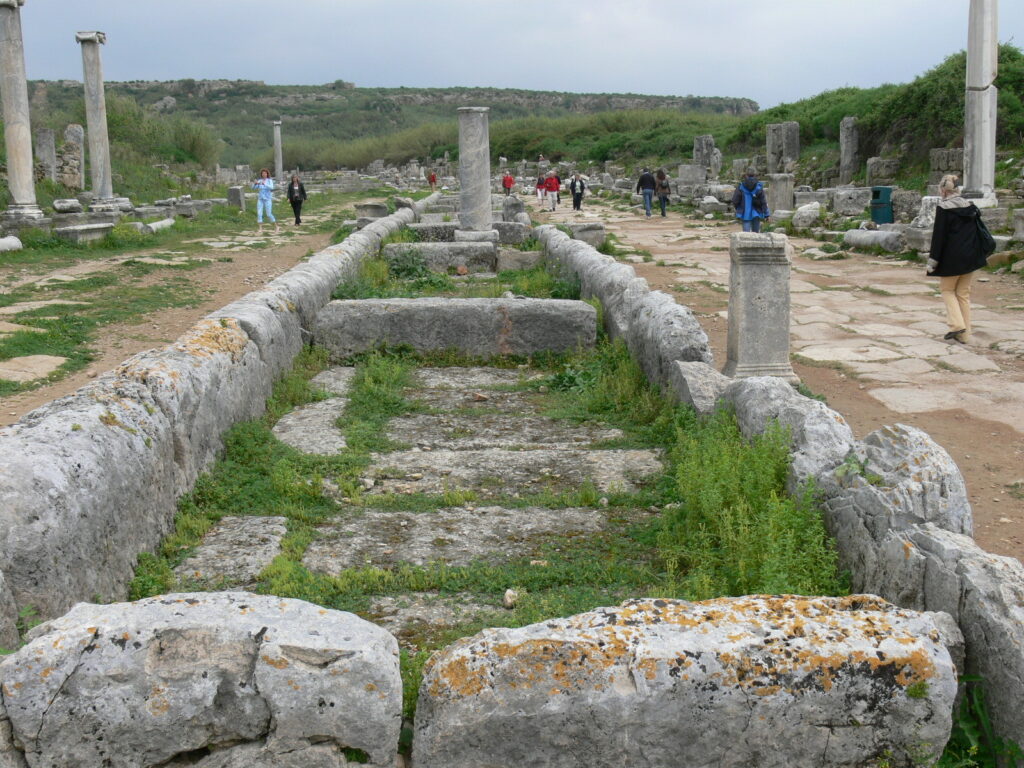
According to Greek mythology the legendary origins of Perge date back to the 13th century BC, when Greek immigrants arrived to Pamphylia, traversing Asia Minor after the Trojan War. The leaders of this movement were supposed to be three famous seers – Mopsos, Calchas and Amphilochus. The first two of them had been recognized as the founders of Perge. The first settlement in Perge area developed on the acropolis hill, to the north of the best-preserved ruins of the later period that are located on the plain below. The earliest archaeological finds from the area of the acropolis of Perge are dated to the end of the fifth millennium BC. The oldest traces of continuous settlement begin in the third millennium BC and demonstrate that the city existed until the Byzantine era. Based on a clay tablet found in the Hittite capital, Hattusa, some scholars identify Perge with a Hittite city of Parha. During the reign of the Hittite king Tudhaliya IV, i.e. at the end of the 13th century BC, a peace treaty was signed the king Kurunta of Tarhuntassa, who waged war with the city of Parha on the river Kashtraia, identified with Kaistros of antiquity.
Greek and Hellenistic period
In the 4th century BC Perge reappears in written sources, when its existence is reported by a writer known as pseudo-Scylax, the author of Periplus – a quasi-scientific geographical account of a clockwise circumnavigation of the Mediterranean and Black Sea. Pseudo-Scylax describes the city on the river Kaistros (now Aksu), situated 10 km away from the seaside, but profiting from maritime trade. The wealth of the city resulted from the fact that the river Kaistros was navigable in these times. Perge was then connected with the coast by the road leading to the port of Magydus that is now a district of Antalya called Lara.Until 334 BC, as all other cities of Pamphylia such as Aspendos, Perge was in the zone of Persian influence. When the Macedonian army, led by Alexander the Great, reached this region Perge surrendered immediately, opening its gates to the Macedonians. The residents of Perge even offered Alexander their help and services as guides in Pamphylia. Around 300 BC Perge acquired the status of a colony of Pergamon. Then the settlement was expanded and acquired a typically Hellenistic character. In the second century BC the city experienced the first period of prosperity and started minting its own coins with the image of Artemis.
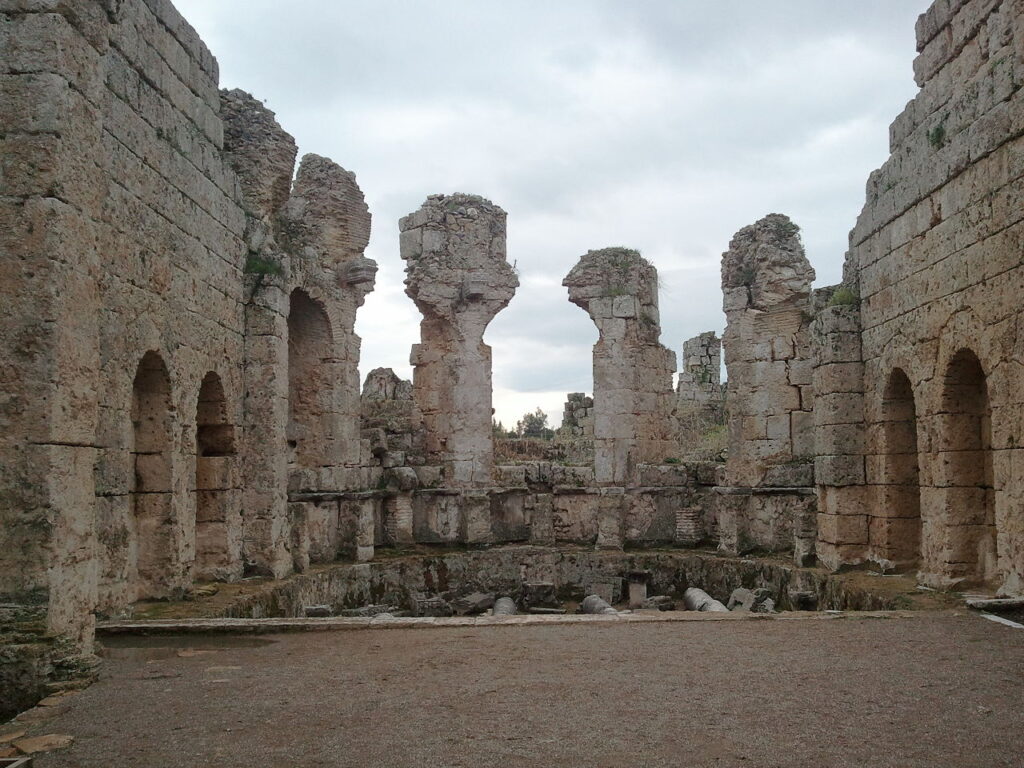
The most famous born in Perge was an outstanding mathematician and astronomer, Apollonius (c. 262 BC – c. 190 BC). He is considered to be one of the greatest Greek mathematicians, on a par with Archimedes. Apollonius belonged to the Alexandrian school of thought and his most important work, preserved only in fragments, was Conics (Κωνικά) in which he came close to developing analytic geometry. He was given a title of the great geometer that he obtained by identifying and giving the names of conic sections i.e. the hyperbola, the parabola, and the ellipse. He also dealt with the problems in the field of astronomy and created the hypothesis of eccentric orbits to explain the apparent motion of the planets and the varying speed of the Moon. The crater Apollonius on the Moon was named in his honor.
Roman and Byzantine rule
In 188 BC Perge came under the Roman rule, and in 129 BC it was formally incorporated into the province of Asia. When a new Roman province, Galatia, covering an area of central Anatolia was created in 25 BC, the Romans decided to connect it to the coast of the Mediterranean Sea. Soon a new road – Via Sebaste – was constructed, linking Pisidian Antioch in Galatia with Perge in Pamphilia. Christianity reached Perge in the first century Ad and was introduced to its inhabitants by Paul the Apostle. He came to Perge by the sea route, during his first missionary journey (45-48 AD), in the company of Barnabas and John Mark, but soon went on his way, to Pisidian Antioch. On the way back to the coast of St. Paul stayed in Perge for a longer time, preaching and teaching. Most likely it was when the first church in Perge was erected. The journey of Paul the Apostle is now commemorated in the form of a hiking trail that starts in Perge and leads all the way to Pisidian Antioch.

In the first and second centuries AD Perge was one of the greatest cities in Asia Minor, competing with Side for the role of the Pamphylian capital. Most of the best preserved buildings in the city are dated to this period. The person responsible for the development of Perge was Plancia Magna, the wife and sister of Roman senators, born into the family of Cappadocian kings and a relative of Herod the Great. Her statue, found near the Hellenistic Gate in Perge, is now in the Archaeological Museum in Antalya. The third and last period of city prosperity came in the 5th and the 6th centuries AD, when the city had a rank of a bishopric. Unfortunately, the end of Perge was very close, as in the 8th century it was razed to the ground during the Arab invasions of Asia Minor and has never been rebuilt.
Archaeological researches
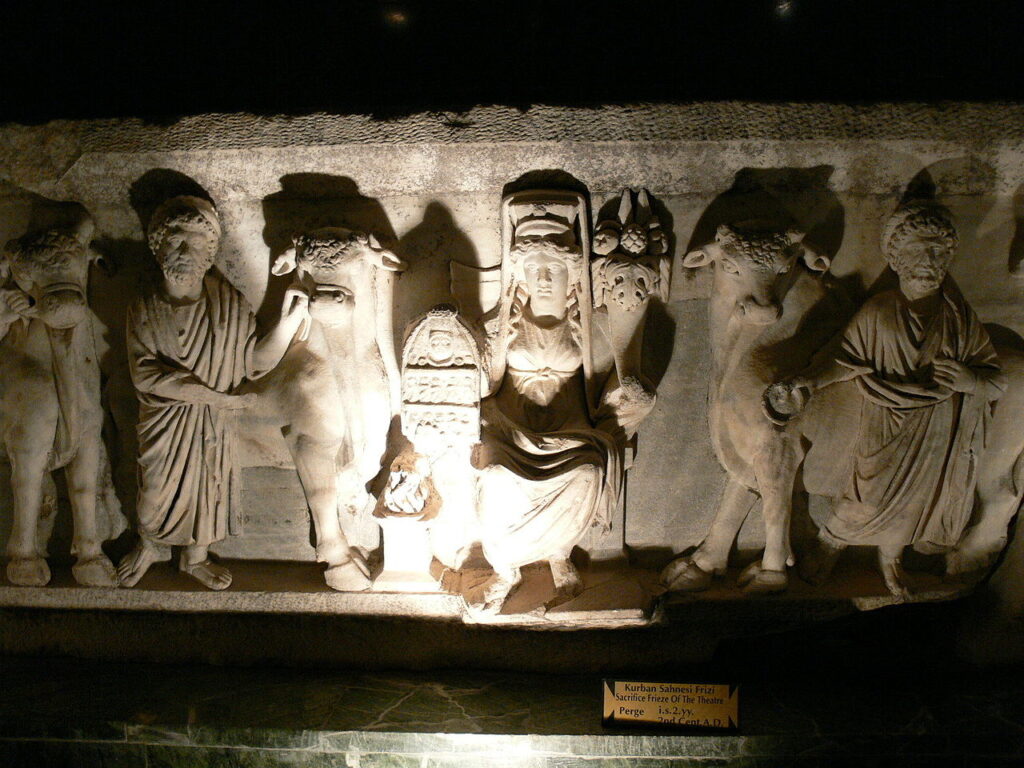
Karol Lanckoroński, Polish researcher and explorer, arrived to Perge in the second half of the 19th century. He likened the landscape around this ancient city to Campania in Italy. Lancoroński prepared a detailed description of the visible ancient buildings in the city that was soon published, along with the city plan and sketches made by George Niemann, in the first volume of The Cities of Pamphylia and Pisidia. The first systematic archaeological excavations in Perge were conducted in 1946 and between 1953 and 1957 by professor Arif Müfid Mansel, who acted on behalf of the Turkish Historical Society. In 1967, the work was resumed, under the same management, within the framework of the Istanbul University research program. After the death of professor Mansel in 1975 his role was taken over by professor Jale İnan and the excavations are still ongoing, now with professor Haluk Abbasoğlu as the team leader.
Main Buildings
The area of ancient Perge is very vast and the visit to it takes at least three hours. The best preserved buildings of the city – the theater and the stadium – are located on the access road to Perge and you can see them without buying the ticket.
Theatre

The impressive building of the ancient theater stands on the road to Perge, on its western side. This building combines Greek and Roman features and was probably built around 120 AD. The auditorium rests on the slope of a hill, and its shape exceeds a semicircle. Roman-style made diazoma is supported by a vaulted substructure. The colonnaded gallery around the top of the auditorium and the stage building still standing to a considerable height, are characteristic for Roman theaters. Perge theater could accommodate approximately 15,000 spectators. The skene building, built in the second half of the 2nd century AD, was two-storied and richly decorated. It stood on the podium, which was ornamented with reliefs depicting mythological scenes, including the episodes from the life of Dionysus. These reliefs, as well as many sculptures that were found in the theater, are currently in the collection of the Archaeological Museum in Antalya. Unfortunately, the theater has been closed to public for many years, because of the ongoing renovation.
Stadium

Perge boasts the second best-preserved ancient stadium, located in Turkey – only the stadium of Aphrodisias is in a better state. The stadium of Perge was built in the 2nd century AD and could accommodate 12,000 spectators. It is 234 meters long and 34 meters wide, and these dimensions make it one of the largest of its kind. The auditorium consisted of 12 rows of seats, supported on a barrel-vaulted construction. There were 30 vaults on the longer side of the stadium and 9 on its northern end. Every third vault was open, leading directly to the arena. The inscriptions discovered inside some of the vaults indicate that they served as shops. On the northern side of the stadium an arena for gladiatorial combat was found. In order to protect the viewers from the lowest row of seats a low wall separated it from the audience.
Tomb of Plancia Magna
Just before you enter the city of Perge through its magnificent city gates, take a look at the tomb of Plancia Magna, standing in front of the city walls. Plancia Magna sponsored the erection of many buildings in the city and her name appears on several inscriptions.
Roman gates

The access to Perge was through the gates in the ramparts of the city. Today, tourists coming to Perge must pass through these tremendous gates. First you need to enter two gates erected in Roman times. Between them there is a courtyard built in the 4th century AD. The outer gate was built during the reign of Emperor Septimius Severus. Both sides of the gate were protected by high towers. The inner gate, also from the time of Septimius Severus, leads through the southern city wall from the courtyard into the city itself. The front arcades that adorn it are from earlier times and date back to the reign of Emperor Hadrian. When a new line of ramparts was constructed in the 4th century AD, the entire structure was incorporated into it. The central arch of the gate remained open to enable the passage of the traffic into Perge.
Hellenistic gate and the inner courtyard
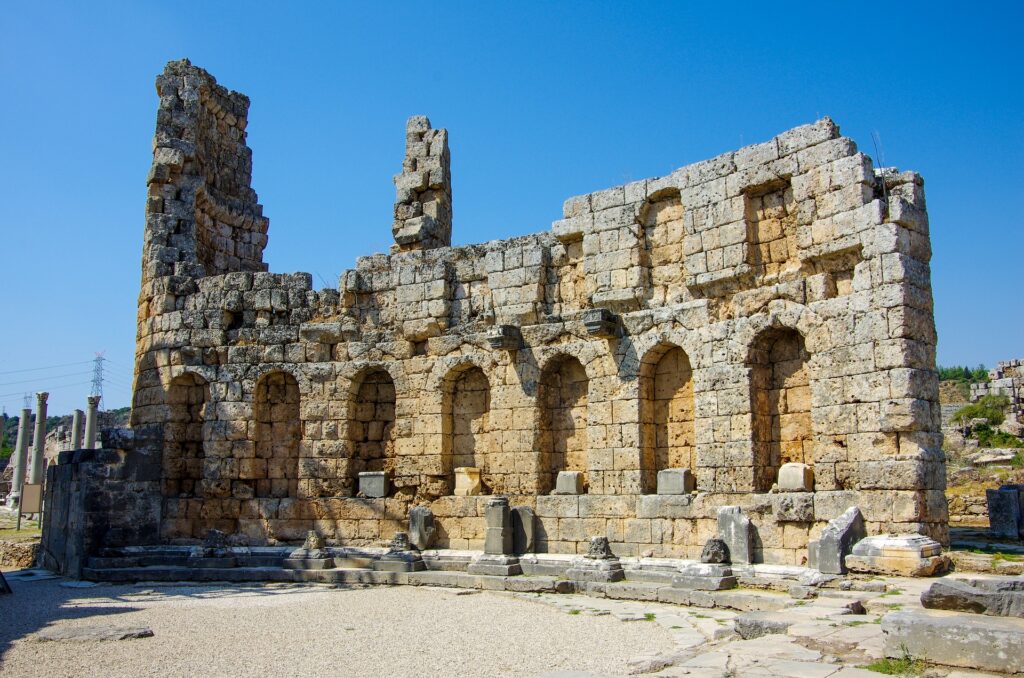
The Hellenistic gate in the ramparts of Perge is probably the most iconic symbol of the city. It consists of two towers with circular basis, built of hewn stones, standing on both sides of the city gate.The structure was erected in the Hellenistic period, but was later rebuilt. In 120-122 AD Planica Magna funded the reconstruction of its inner, horseshoe-shaped courtyard. The walls were covered with marble blocks and a two-stories colonnade in Corinthian order was added. The niches between the columns of the upper story held the statues of Perge’s legendary founders, Mopsos and Calchas. On the lower level the statues of Greek deities, including Hermes, Aphrodite and Pan, were placed. In 2013, the gate was being renovated and the access inside this structure was not possible. On the northern side of the courtyard a two-storied structure with three gates was built. It slightly resembles the famous Hadrian’s Gate in Antalya. The niches in the building were decorated with the statues of Roman emperors, their spouses and civil servants, starting from the period of the reign of Nerva to Hadrian. Most of these monuments were found during the first round of the archaeological works in Perge and now decorate the Archaeological Museum of Antalya.
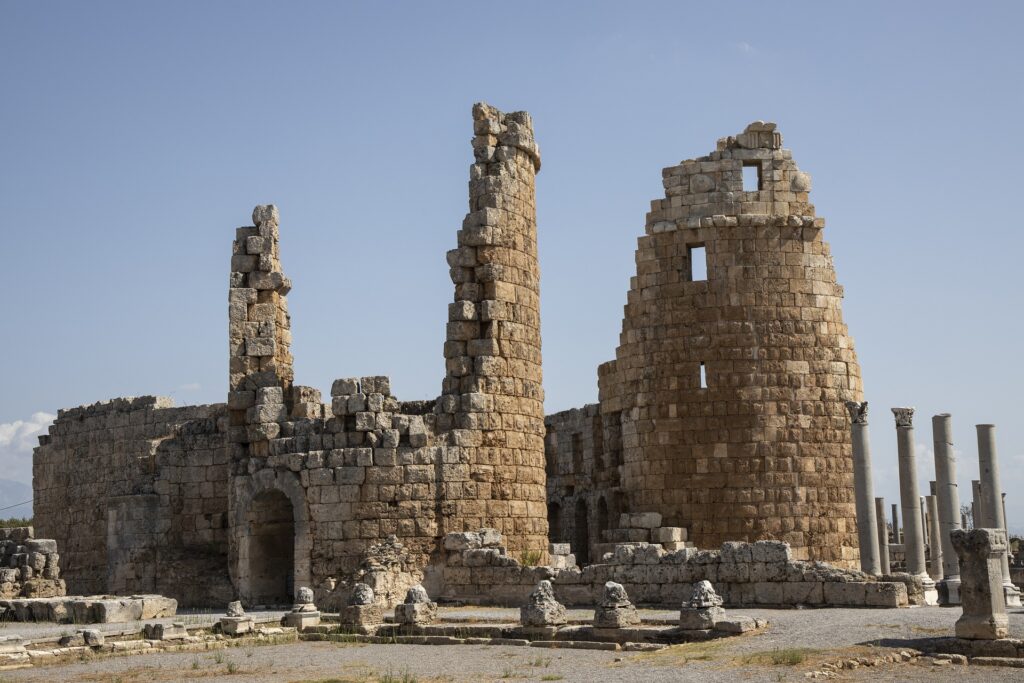
Between the Hellenistic gate and the Roman gate there is a vast courtyard, 92 meters long. It was also adorned with statues, including the monument of Plancia Magna. On the western side of the courtyard there is a propylaea (a monumental gate) leading to the baths. This gate were decorated with the reliefs of Greek deities, including Selene, Dionysus and Eros. According to inscriptions it was constructed during the reign of the Emperor Septimius Severus, at the end of the 2nd century AD. Also on the western side, to the south from the monumental gate, there are the ruins of a nymphaeum – a monumental fountain complex consisting of a water cistern and an ornamental façade. The building was dedicated to Artemis of Perge, the Emperor Septimius Severus, his wife and his sons. The statues of the imperial family, preserved in an excellent state, are displayed in the Archaeological Museum in Antalya.
City walls
The city was surrounded by a ring of walls, built in the 3rd century BC, with rectangular towers placed at even intervals. Long sections of these walls are still standing, especially on the eastern side of the city and some of the towers reach their original height.
Roman houses
Near the eastern section of Perge city walls ramparts the excavations have revealed the remains of residential houses. These buildings consisted of several rooms arranged around an atrium, and some of them were two-storied. Each property had a water cistern and a toilet, which means a sewage system existed in the city. The floors of some rooms were covered with mosaics. These estates were occupied from the 3rd to the 6th century AD.
Colonnaded streets
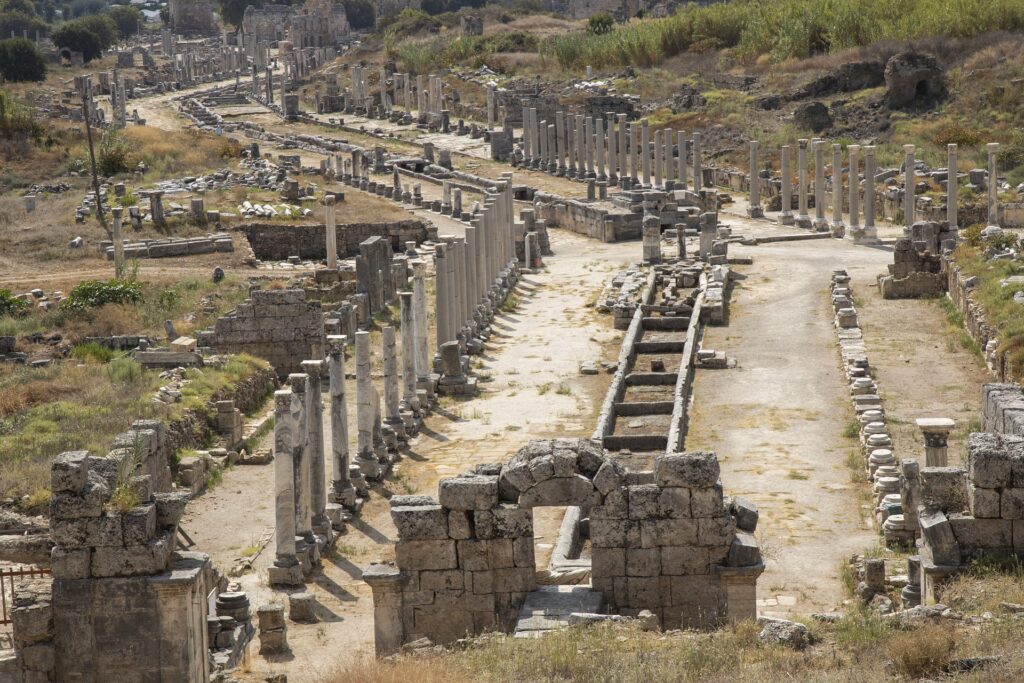
Perge is divided into four districts by two main colonnaded streets that cross at the center of the city. One of these streets leads from the city gates to the foot of the Hellenistic acropolis hill and has a length of 300 meters. There is still a nicely preserved colonnade running along this street and it is worth paying attention to three columns decorated with reliefs. They depict Artemis of Perge, Tyche – the goddess of fortune and one of the mythical founders of the city – Calchas. Both sides of the street were once lined with shops and their scanty remains can be seen while walking to the acropolis. The second main street in Perge leads from the east to the west. At both ends of this street there were gates in the city walls. The canals that supplied water to the fountains and baths run in the middle of both streets and they used to provide refreshment from the strolling inhabitants of Perge. Underneath there was a sewer system, hidden from the view. Nowadays there’s no water running in the canals, so bring your own supply for the visit. At the intersection of the main streets a triumphal arch was erected, known as the arch of Demetrios and Apollonius. It was built around 80 AD, but not much of it is now visible. On the basis of the discovered architectural elements the researchers were able to reconstruct its original appearance and are now planning to rebuild this structure.
Hadrian’s nymphaeum
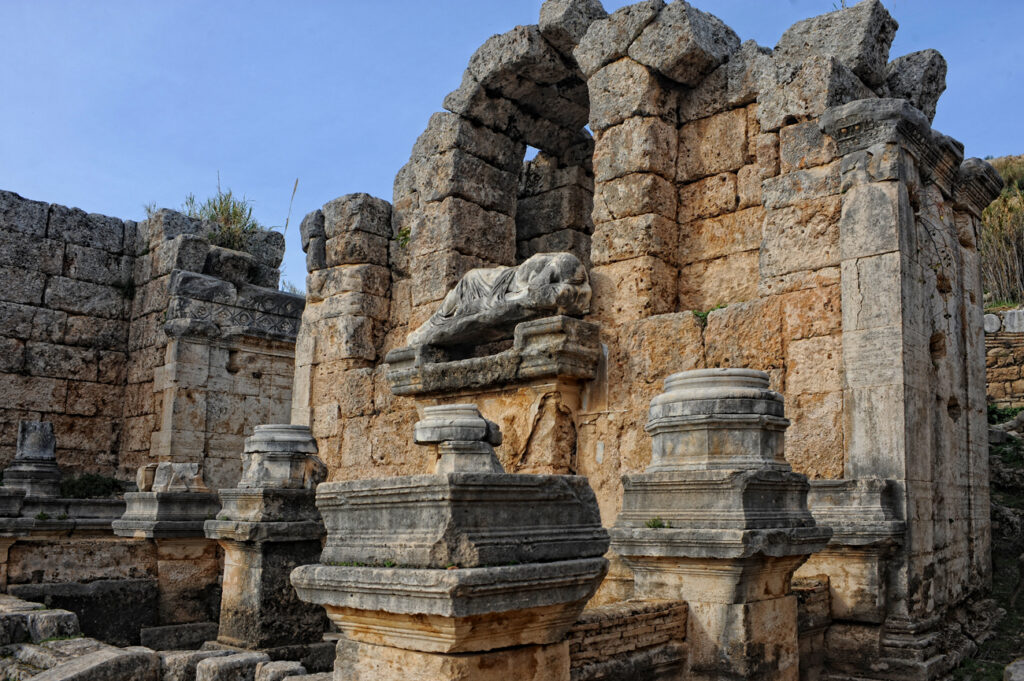
At the northern end of the colonnaded street stands a beautiful nymphaeum, called the fountain of Hadrian, because of the date of its of construction. This name also helps to distinguish this fountain from the other one, situated on the southern part of Perge. Hadrian’s nymphaeum is supported by the southern slope of the Acropolis hill and marks the starting point of a canal that distributed the water to various districts of the city. The Hadrian’s nymphaeum was erected on a U-shaped plan and its base has the dimensions of 21 by 9 meters. This two-storied building was once also used as a gateway to the acropolis. There were two entrances to the structure and between them was a decorative façade with a statue of Cestros – the god of Kaistros river. The nymphaeum has partly collapsed, but this statue is still in its place. The other two statues of Emperor Hadrian have been transported to the Archaeological Museum in Antalya.
Palaestra

If you turn right, instead of heading directly from Hadrian’s nymphaeum to the city gates, the colonnaded street running along the east-west axis, will take you to the palaestra. The structure was dedicated to the Emperor Claudius by Julius Cornutus, Magna Plancia’s husband. This well-preserved building was erected from travertine on a square plan, with the sides 76 meters long. The palaestra was a place for physical exercises and consisted of an open courtyard surrounded by changing rooms. Running water was supplied by an aqueduct.
Northern baths
Walking from the palaestra further to the east you can reach the northern baths of Perge. So far no systematic excavations have been carried out here, but its travertine walls and several arches are clearly visible. The building was constructed in the 3rd century AD and it’s one of the finest examples of monumental baths in Pamphylia region. The baths have a typical Roman plan, with five rooms and a courtyard.
Roman baths
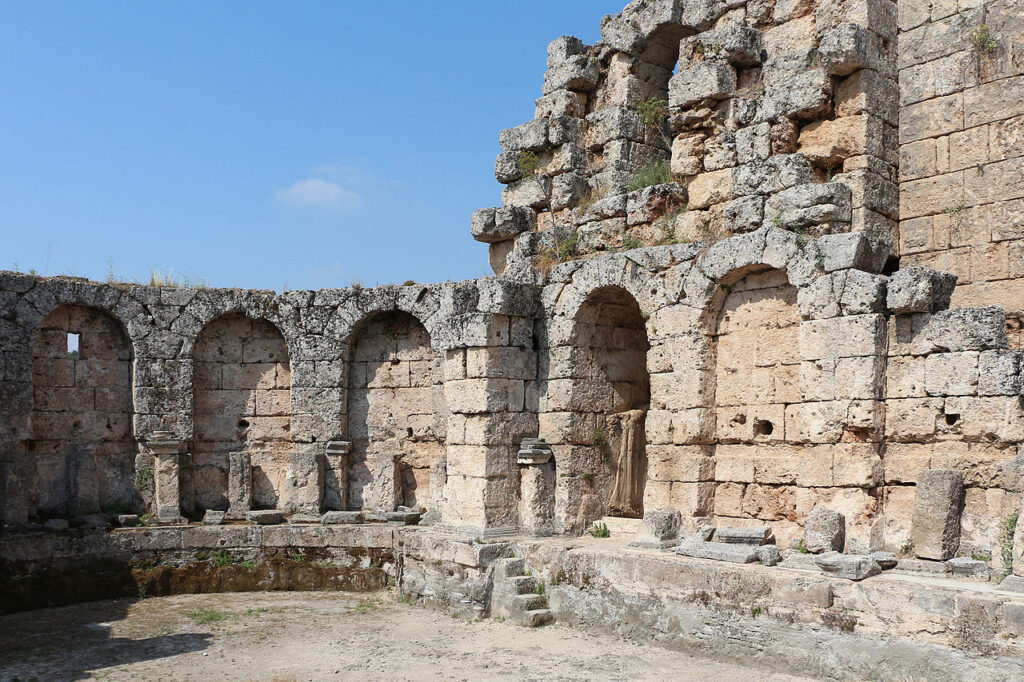
The second baths in Perge stand on the west side of the Hellenistic gate. A monumental gate leads to this imposing edifice from the Roman times that belongs to the best-preserved Roman baths in Turkey. These baths consist of a sequence of rooms with windows opening up to the south. You can visit frigidarium or cold water room with a swimming pool, tepidarium – a room with warm water and caldarium – a room with hot water. The fragments of thin marble slabs, which once lined the brick walls, are still in place. In two rooms you can see the exposed heating system – the floor was supported on brick pillars and the air heated in the boiler room was circulating underneath.
Churches
There are several Christian shrines in the area of Perge. In the southern part of the city you can see the remains of the church from the 6th century AD, with an apse located on its eastern side. In the center of Perge, it is possible to find the ruins of a three-nave basilica, which dates back to the 5th or 6th century AD.
Agora

On the eastern side of the Hellenistic gate the agora of Perge is located. This square-shaped area with a each side 65 meters long was was built in the 4th century AD. The agora was surrounded by colonnades where the shops once offered various good to the inhabitants of the city. The circular structure in the center of the agora resembles a similar structure in the agora in Side – that is a recently reconstructed temple of the goddess Tyche. It is believed, however, that in Perge building served as a fountain. Right on the agora, on the south-eastern side, there are some traces of the public latrine, which was connected to the sewer system.
Acropolis
The acropolis hill dominates the northern side of Perge. In this area the oldest traces of human settlement have discovered, however, most of the buildings excavated by archaeologists on the acropolis date back to the Byzantine times.
Necropolis

The main necropolis of Perge was situated just outside the city walls, on the western side of the city. The second, smaller necropolis was located on the eastern side. Within these cemeteries many kinds of tombs and sarcophagi have been identified and their finest specimens are now exhibited in the Archaeological Museum in Antalya.










